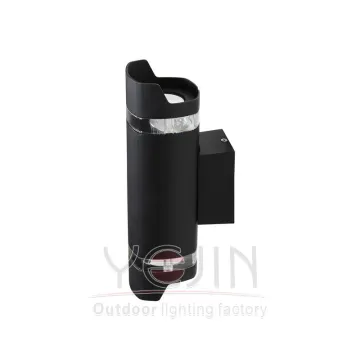7 Things to Think About when Choosing LED Garden Lights
Feb. 26, 2022
As an Outdoor Garden Lamp supplier, we’ve put together an exhaustive guide to LED garden lighting, to help you choose the perfect lights for your outdoor space.
IP ratings
As we've already mentioned, IP rated lights are ideal for gardens, as they will continue to work in adverse weather conditions.
The IP stands for Ingress Protection, and it denotes how protected a light is from the ingress of water and solid objects. It is made up of two numbers, the first of which tells you how protected the equipment is from solid objects, the second how protected it is from water. The higher the numbers, the greater the protection.
For solid objects, the rating can be between 0 (not protected) and 6 (completely dust-tight), while for water, the rating goes from 0 (not protected) to 8 (completely watertight and suitable for immersion in water up to 1 metre deep).
For outdoor areas, look for lighting with an IP rating of at least 44. This means it will be protected against the ingress of objects up to 1mm in size (so most soil and dirt) and will withstand splashing water.
If possible, look for IP65 rated lights. These offer excellent protection and will withstand even the most extreme of British weather, and even directional water jets, such as hosepipes. Ratings above 65 and 66 are rare, and only really necessary if the equipment is going to be exposed to heavy amounts of water.
Brightness
A light's brightness is obviously one of it's biggest characteristics, and with LED garden lighting, it is even more important. An LED security light, for example, must be bright enough for its intended purpose, while solar-powered path lighting doesn't need to be bright enough to light every nook and cranny of your garden.
When determining the brightness of a light, look for its lumens (lm) rating. The higher this rating, the brighter the light. Most standard solar LED lights will have a lumens count of between 5-10lm, while more powerful solar spotlights might be between 15-25lm.
At the other end of the scale, outdoor floodlights are designed to be bright, so can have a lumens count of anywhere between 800 and 22,000lm! Those at the higher end of the scale are designed for more commercial spaces, such as the illumination of car parks, and are unsuitable for gardens. To get a rough idea of what sort of brightness you should be looking for in a floodlight, have a look at the table below.表格
Lifespan
Everyone wants their lighting to last as long as possible. One of the inherent benefits of LED lighting is that it lasts much longer than traditional incandescent lighting. A halogen floodlight (or the light bulb, at least) might give you 2,000 hours of use, while an equivalent LED floodlight can easily last more than 20,000 hours, ten times that of a halogen light.
To put that into perspective, even if you had the LED floodlight on for eight hours a night, every night, it would still last for around seven years before it needed replacing. The halogen version, on the other hand, wouldn't even last a year.
PIR motion sensor floodlights will last for even longer, as they only activate when they detect a presence. This helps to minimise wasted energy and extends the lifespan of the fitting considerably.
Ease of installation
When buying outdoor lighting, take into account how complicated they might be to install, whether you will be able to do it yourself, or if you will need the help of a professional. For mains powered lighting, we would always recommend the latter option unless you are totally confident in your abilities to install the equipment yourself. This ensures that the light will be installed safely, but does mean an extra expense.
Solar-powered lights are by far the simplest to install and require little skill or equipment. In most cases, you can have the lights installed within seconds of removing them from their packaging.
Battery-powered LED lights offer a middle ground, sometimes requiring a little DIY knowhow to fix in place, but avoiding the need to touch your mains electrics. If you've ever hung a mirror, picture frame, or shelves, you should be comfortable fitting battery-powered lighting in place.
Colour or colour temperature
The colour of your lighting makes a huge difference to the look and feel of a space, and this is no different for your garden. White lights will create a cosy, welcoming feel, while multi-coloured lighting will give your garden a more festive atmosphere.
You will probably have an idea from the start about what colour lighting you want in your garden, but the colour temperature is a different matter and is often one of the most overlooked features of lighting.
Colour temperature applies to white light and describes how ‘warm' (yellow) or ‘cool' (blue) the lighting is. It is measured in Kelvins (K), and the higher the number, the cooler the light.
For example, white lighting with a colour temperature of 2700K gives off a warm, yellowy light, ideal for creating a cosy, relaxed atmosphere. On the other hand, lighting with a colour temperature of 4000K will emit a cooler, white light and a colour temperature of 6500K gives a noticeably bluer, light.
Sockets and switches
Some mains powered lighting, such as deck lighting, will require an IP rated outdoor socket. It's always worth knowing if you have one installed already, as a new one will need to be fitted by a qualified electrician, which will add to your expenses.
Please note, outdoor sockets must be suitably weather protected, ideally with an IP rating of 65 or higher. If not, they could create a serious hazard should any water enter the enclosure. IP rated outdoor sockets are distinctive, as they are bigger and bulkier than standard sockets, and will have a cover on the front.
The same goes for switches. If you want to be able to switch your outdoor lights on and off from outside, they will need connecting to a suitably IP rated switch.
Standard switching vs PIR sensors vs dusk till dawn lighting
Have you considered how you want your lighting to activate?
When choosing LED security lighting, in particular, you have a range of options for switching the light on and off. You can use a standard switch to do it manually, although there's always the risk of leaving the light on during the day, wasting energy and shortening its lifespan.
Passive infrared (PIR) motion sensor floodlights, on the other hand, only activate when a presence is detected. This is the most energy-efficient option, as the light is only active when it needs to be, although the sensor can sometimes pick up the movement of animals or neighbours in their own gardens.
Finally, ‘dusk till dawn' floodlights contain light sensors that allow them to activate only when it gets dark enough outside, switching off again in the morning when it gets bright enough. These offer a middle ground between standard floodlights and PIR floodlights, as they will be on throughout the night, but you don't need to worry about switching them off again during the day.
We are an Outdoor Garden Lamp supplier. Please feel free to contact us if you need them!








